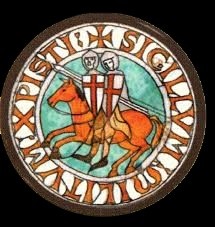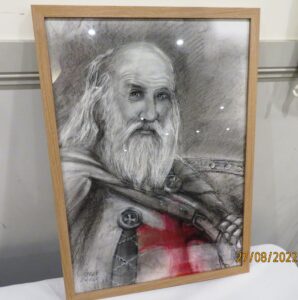 Jacques de Moley, last Grandmaster 1292 until 1314
Jacques de Moley, last Grandmaster 1292 until 1314
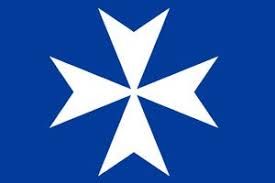
Amalfi Cross – this is a so-called Maltese Cross
This Amalfi Cross was adopted by many medieval orders and sanctioned to sport on their mantle by the Pope. After the crusades ended all military orders dispersed and followed their individual prerogatives. One of them, the Order of Malta (Order of the Knights Hospittaler, Order of St. John, Order of Rhodes) moved to Cyprus until 1310, and then to Rhodes until 1522. Defeated by the Muslim forces they escaped to Sicily. The Sovereign Military Order of Malta established a mission in Malta (1998) and uses Fort St. Angelo for 99 years only. This order has no observer status with the UN. Only the OSMTH is recognised as adviser to the UN at the NGO office.
The history of that cross: The duke of Amalfi, created that cross and placed it on his flags, flying at his castle San Nicola de Thoro-Plano
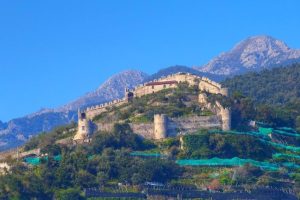 and showing on his coins.
and showing on his coins. 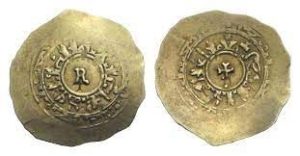 Those gold and silver coins were brought to the Holy Land by the Amalfi Bishop and circulated with greater success (the weight increased the value) than other legal tender. From here, the cross found its way onto the mantles of medieval knights, and until today is worn by various Orders. But, it never changed its name, it was and always will be an Amalfi Cross.
Those gold and silver coins were brought to the Holy Land by the Amalfi Bishop and circulated with greater success (the weight increased the value) than other legal tender. From here, the cross found its way onto the mantles of medieval knights, and until today is worn by various Orders. But, it never changed its name, it was and always will be an Amalfi Cross.
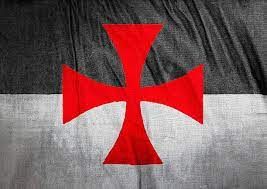
TEMPLAR FLAG: From the time onwards when the Templars and Hospitallers were fighting side by side. this black and white flag with the red Templar Cross was used to indicate the position of the Templar Knights.
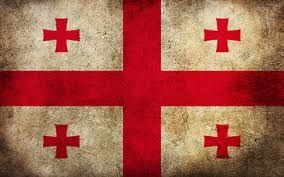
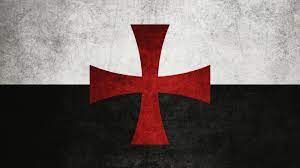
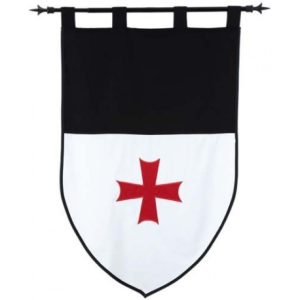
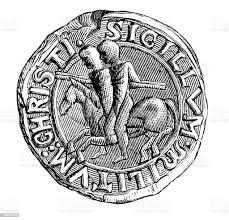
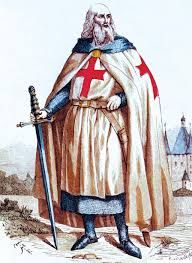
1 They created a brand new model of holy warrior. The members were monks, sworn to poverty, chastity, obedience and committed to fight ‘infidels’.
2 They didn’t joke around when it came to discipline. Under the ‘Templar Rule’, a detailed code governing everyday behaviour, the knights were required to live austere lives.
3 They refused ever to surrender. The opposite to Christian forces, who were ragtag armies with minimal training; the Templar Knights were highly trained fierce forces.
4 They were strategic thinkers as well as zealous fighters. They prevented new arriving Christians to picking fights as soon as possible; instead those new-comers were trained and integrated in a big army.
5 For poor knights, they were unbelievably rich. Individually poor, as group they were astonishing wealthy, because they received huge donations and did not pay any tax.
6 They were a full-service financial service group. Travellers to the Holy Land could deposit cash in Europe and the letter of credit (todays cheque) could be redeemed in any Commandery on the way.
7 They understood how Islamic institutions worked. The Arabic Madrasah, a place where Sunni scholars debated law, was introduced in England as Inn of Court.
8 They were so powerful a king went to war with them. After the crusades failed, the Order thought about to create an independent state in south-eastern France, but King Philip IV. together with his cousin Pope Clement IV. declared war on them. The German Teutonic Knights at that time succeeded and created their own country, spreading all over todays territory of Lithuania, Latvia and Estonia.
9 The downfall was dramatic. At dawn on Friday 13, 1307, French officials arrested all Templar Knights. They were tortured to extract confessions about sinful, criminal behaviours and the order was formally dissolved in 1312.
10 They remained influential long after that date. Templar in some countries refused to follow the French way and Knights simply changed their names and outfits. Unfortunately the Templar Knights are depicted as shadowy organisations, especially in movies and books. Quite contrary, Templar Knights are active today in more than 34 countries worldwide and have two members as advisors to the United Nation Assembly in the NGO department.
